The NVIDIA GeForce GTX 970 Review: Featuring EVGA
by Ryan Smith on September 26, 2014 10:00 AM ESTCompute
With GTX 980 NVIDIA surprised us with their stunning turnaround in in GPU compute performance, which saw them capable of reaching the top in many compute benchmarks they couldn’t before. GTX 970 meanwhile should benefit from these architectural and driver improvements, though since compute is nearly analogous to shader performance this is also a case where the performance difference between the GTX 970 and GTX 980 stands to be among its widest.
As always we’ll start with LuxMark2.0, the official benchmark of SmallLuxGPU 2.0. SmallLuxGPU is an OpenCL accelerated ray tracer that is part of the larger LuxRender suite. Ray tracing has become a stronghold for GPUs in recent years as ray tracing maps well to GPU pipelines, allowing artists to render scenes much more quickly than with CPUs alone

Thanks to GTX 980 taking the top spot here, GTX 970 still maintains a small lead over R9 290XU. So even with the GTX 970's weaker performance, it can still manage to outperform AMD's flagship in this case.
For our second set of compute benchmarks we have CompuBench 1.5, the successor to CLBenchmark. We’re not due for a benchmark suite refresh until the end of the year, however as CLBenchmark does not know what to make of GTX 980 and is rather old overall, we’ve upgraded to CompBench 1.5 for this review.
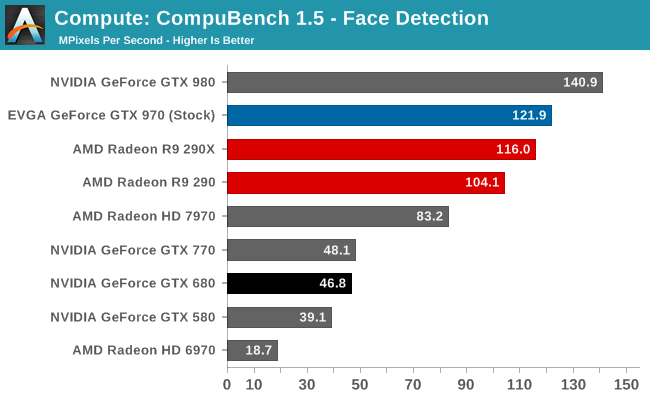
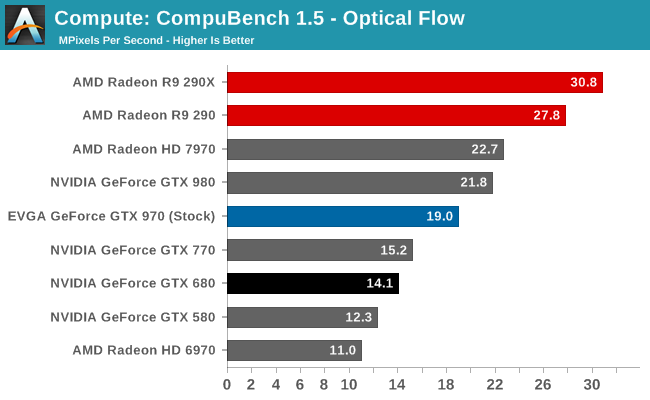
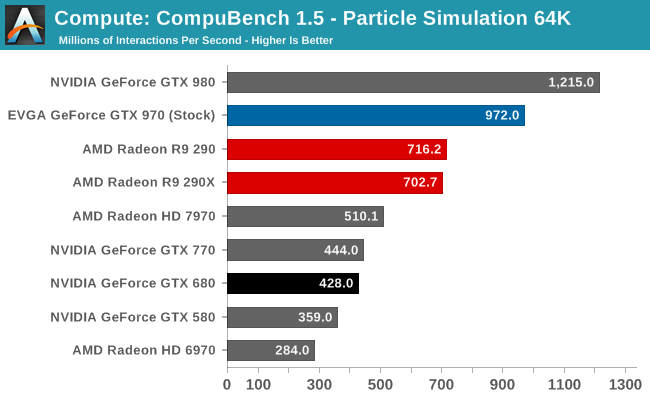
In the cases where the GTX 980 does well, so does the GTX 970. In the cases where the GTX 980 wasn’t fast enough to top the charts, the GTX 970 will be similarly close behind. Overall compared to AMD’s lineup we see the whole gamut, from a tie between the GTX 970 and R9 290XU to victories for either card.
Our 3rd compute benchmark is Sony Vegas Pro 12, an OpenGL and OpenCL video editing and authoring package. Vegas can use GPUs in a few different ways, the primary uses being to accelerate the video effects and compositing process itself, and in the video encoding step. With video encoding being increasingly offloaded to dedicated DSPs these days we’re focusing on the editing and compositing process, rendering to a low CPU overhead format (XDCAM EX). This specific test comes from Sony, and measures how long it takes to render a video.
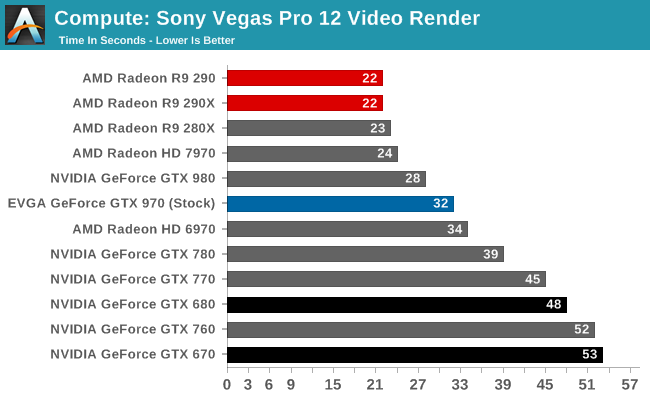
As expected, GTX 970 sheds a bit of performance here. AMD still holds a lead here overall, and against GTX 970 that lead is a little bit larger.
Moving on, our 4th compute benchmark is FAHBench, the official Folding @ Home benchmark. Folding @ Home is the popular Stanford-backed research and distributed computing initiative that has work distributed to millions of volunteer computers over the internet, each of which is responsible for a tiny slice of a protein folding simulation. FAHBench can test both single precision and double precision floating point performance, with single precision being the most useful metric for most consumer cards due to their low double precision performance. Each precision has two modes, explicit and implicit, the difference being whether water atoms are included in the simulation, which adds quite a bit of work and overhead. This is another OpenCL test, utilizing the OpenCL path for FAHCore 17.
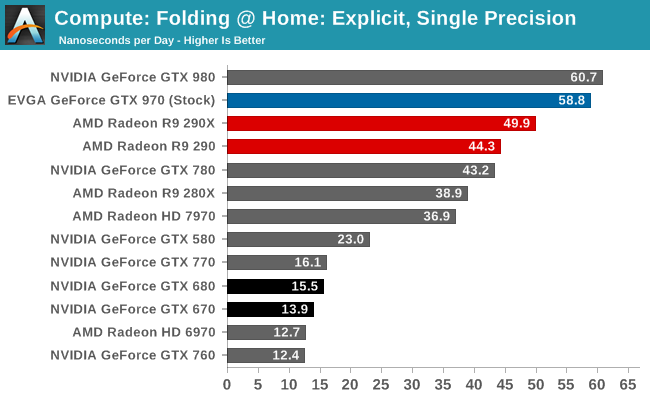
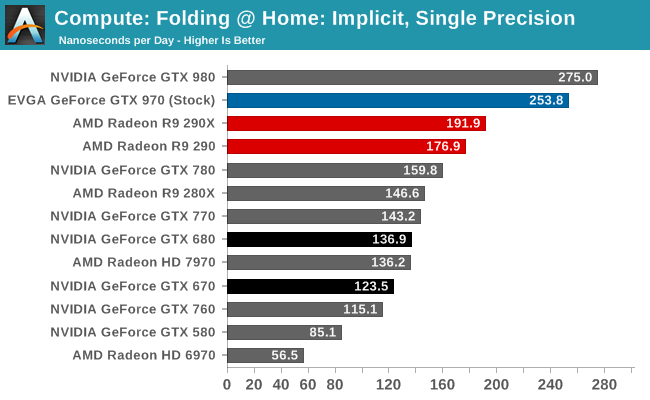
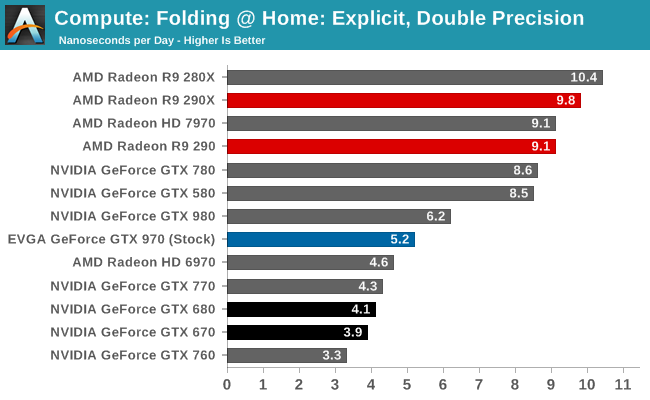
With the GTX 980 holding such a commanding lead here, even with the GTX 970’s lower performance it still is more than enough to easily beat any other card in single precision Folding @ Home workloads. Only in double precision with NVIDIA’s anemic 1:32 ratio does GTX 970 falter.
Wrapping things up, our final compute benchmark is an in-house project developed by our very own Dr. Ian Cutress. SystemCompute is our first C++ AMP benchmark, utilizing Microsoft’s simple C++ extensions to allow the easy use of GPU computing in C++ programs. SystemCompute in turn is a collection of benchmarks for several different fundamental compute algorithms, with the final score represented in points. DirectCompute is the compute backend for C++ AMP on Windows, so this forms our other DirectCompute test.

Recently this has been a stronger benchmark for AMD cards than NVIDIA cards, and consequently GTX 970 doesn’t enjoy quite the lead it sees elsewhere. Though not too far behind R9 280X and even R9 290, like GTX 980 it can’t crunch numbers quite fast enough to keep up with R9 290XU.










155 Comments
View All Comments
JarredWalton - Friday, September 26, 2014 - link
There are plenty of older (but still decent) PSUs that only have 6-pin PEG connectors, and 6-pin to 8-pin adapters are never a good idea IMO.cobalt42 - Friday, September 26, 2014 - link
I believe at least one released card does use a single 8-pin connector.jmke - Tuesday, September 30, 2014 - link
Asus strix 970 DC2OC uses a single 8-pin connectorHrel - Friday, September 26, 2014 - link
Remember you guys saying Nvidia is working from the low end up, no longer top down. Well, they should start releasing cards that way. I don't care about your overpriced space heaters, I care about the cards between $100 and $200. Release those first!cobalt42 - Friday, September 26, 2014 - link
They did -- the 750 and 750Ti are the first generation Maxwell cards, released earlier this year. They didn't break new ground in price/performance, but they did in price/watt.anandreader106 - Friday, September 26, 2014 - link
You mean performance/watt.Houdani - Friday, September 26, 2014 - link
I think it's finally time to upgrade my vintage 460 to one of these 970's. I don't plan on upgrading my ancient i7 930 (Nahelem, Bloomfield) just yet.I think I can eek more life out of my rig by bumping the GPU and keeping the rest of the innards the same for another year or two. I'm just surprised that I was able to get 4 good years out of that little 460 (mated with a 1080P monitor).
CaptainSassy - Friday, September 26, 2014 - link
Exactly the same rig and monitir but i will continue sitting on it :D 329$ is still pricy, i'll wait for true 200$ championwetwareinterface - Saturday, September 27, 2014 - link
there won't be a $200 champion. the bang for buck cards are in the $300 and above price tier right now and for the foreseeable future. it was the r9 290 and now it's the 970. the next one i predict will be the 290's replacement it will have the texture compression of the 285 and be their second down part.just4U - Sunday, September 28, 2014 - link
The $200 champion appears to really be the 280 atm for those sitting on older cards.. I'd like to say the 285 but it's higher up in the price bracket. The 960 should be interesting though when it comes out but I doubt it will be a $200 card.. Looking at the 970.. Im guessing it will sit at the $250 price point.